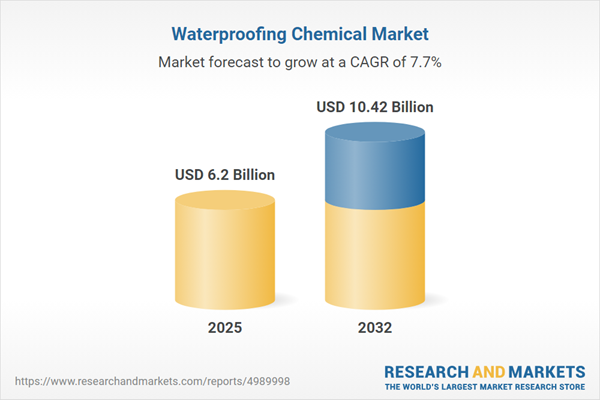Speak directly to the analyst to clarify any post sales queries you may have.
The waterproofing chemical market is evolving amid growing demands for infrastructure durability and sustainable construction practices. Senior decision-makers seek data-driven insights to balance performance, compliance, and operational efficiency in selecting advanced chemical solutions.
Market Snapshot: Growth Trajectory in the Waterproofing Chemical Market
The waterproofing chemical market grew from USD 5.74 billion in 2024 to USD 6.20 billion in 2025. It is projected to maintain a CAGR of 7.72%, reaching USD 10.42 billion by 2032. This upward trend reflects robust industry momentum driven by innovation, infrastructure investment, and regulatory shifts in construction practices.
Scope & Segmentation
Senior executives require a comprehensive outlook to inform procurement, investment, and product strategy in waterproofing chemicals. This report offers granular segmentation and coverage:
- Product Type: Acrylic, Bituminous Coating, Elastomers, Polyurethane Membrane
- Application Area: Basement, Parking Deck, Roof, Terrace, Tunnel, Wall
- End Use Sector: Commercial (Hospitality, Office, Retail), Industrial (Chemicals, Manufacturing, Oil & Gas), Infrastructure (Bridges, Roads, Tunnels), Residential (Multi Family, Single Family)
- Form Factor: Liquid, Powder
- Distribution Channel: Offline (Direct Sales, Distributors, Specialty Stores); Online (Company Website, Third Party Platforms)
- Regional Coverage: Americas (North America, Latin America), Europe, Middle East, Africa, Asia-Pacific
- Company Profiles: Sika AG, BASF SE, RPM International Inc., GCP Applied Technologies Inc., Dow Inc., Arkema S.A., MAPEI S.p.A., The Sherwin-Williams Company, H.B. Fuller Company, Wacker Chemie AG
Key Takeaways for Senior Decision-Makers
- Proactive protection strategies are replacing reactive repairs, with advanced waterproofing chemicals extending infrastructure service life and reducing ongoing maintenance needs.
- Material innovation, including bio-based additives and low-VOC formulations, addresses environmental mandates while meeting high-performance application requirements.
- The integration of nanotechnology and digital monitoring supports self-healing properties and real-time quality assurance, enabling predictive maintenance and asset protection.
- Regional regulatory landscapes and varying climatic demands require flexible product portfolios and agile supply chain solutions for market responsiveness.
- Strategic collaborations such as alliances with polymer specialists and technology providers accelerate product differentiation and digital service offerings.
- Comprehensive segmentation by product, application, use sector, and channel informs targeted strategies for growth and risk mitigation in global markets.
Tariff Impact: Managing Shifts in Raw Material Procurement
- Rising United States tariffs on raw material imports have increased costs and led manufacturers to diversify suppliers and incentivize onshore production capabilities.
- Supply chain recalibration drives investment in alternative sources, process validation, and logistics infrastructure, enhancing resilience and reducing exposure to geopolitical risks.
Methodology & Data Sources
This research combines primary interviews with sector executives and technical experts, alongside secondary data from journals, trade publications, and government databases. Data was validated through triangulation, normalized for accuracy, and analyzed using segmentation frameworks, SWOT, and PESTEL tools to support strategic decision-making.
Why This Report Matters
- Enables senior leaders to anticipate market shifts and regulatory impacts, informing medium- and long-term business strategies and procurement planning.
- Provides actionable intelligence on innovation trends and supply chain dynamics for competitive positioning and investment returns.
- Supports benchmarking of regional and global peers while identifying growth opportunities in product, application, and distribution segments.
Conclusion
The waterproofing chemical market is shaped by innovation, sustainability mandates, and regulatory dynamics. Executives leveraging data-driven insights and strategic partnerships will optimize asset longevity, operational resilience, and future growth in this evolving sector.
Additional Product Information:
- Purchase of this report includes 1 year online access with quarterly updates.
- This report can be updated on request. Please contact our Customer Experience team using the Ask a Question widget on our website.
Table of Contents
3. Executive Summary
4. Market Overview
7. Cumulative Impact of Artificial Intelligence 2025
Companies Mentioned
The companies profiled in this Waterproofing Chemical market report include:- Sika AG
- BASF SE
- RPM International Inc.
- GCP Applied Technologies Inc.
- Dow Inc.
- Arkema S.A.
- MAPEI S.p.A.
- The Sherwin-Williams Company
- H.B. Fuller Company
- Wacker Chemie AG
Table Information
| Report Attribute | Details |
|---|---|
| No. of Pages | 191 |
| Published | October 2025 |
| Forecast Period | 2025 - 2032 |
| Estimated Market Value ( USD | $ 6.2 Billion |
| Forecasted Market Value ( USD | $ 10.42 Billion |
| Compound Annual Growth Rate | 7.7% |
| Regions Covered | Global |
| No. of Companies Mentioned | 11 |









